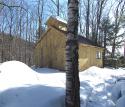
I have always used lead free brass ball valves, by Legend. They have valves with the barbed portion as part of the valve. That makes it much handier. If you can't find them locally, try Seneca Plumbing and Heating in Vernon, NY. I have gotten 3/4" and 1" ones there for 30 years. I never tried to get larger ones, I don't know how large they go. My mains are all 3/4 and 1".
Dave Klish, I recently ordered a 2x6 wood fired evaporator from A&A Sheet Metal which I will be converting to oil fired
Now have solar, 2x6 finish pan, 5 bank 7x7 filter press, large water jacketed bottler, and tankless water heater.
Recently bought another Gingerich RO, this one was a 125, but a second membrane was added thus is a 250, like I had.
After running a 2x3, a 2x6, 3x8 tapping from 79 taps up to 1320 all woodfired, now I'm going to a 2x6 oil fired and a 200-425 taps.














 Reply With Quote
Reply With Quote




